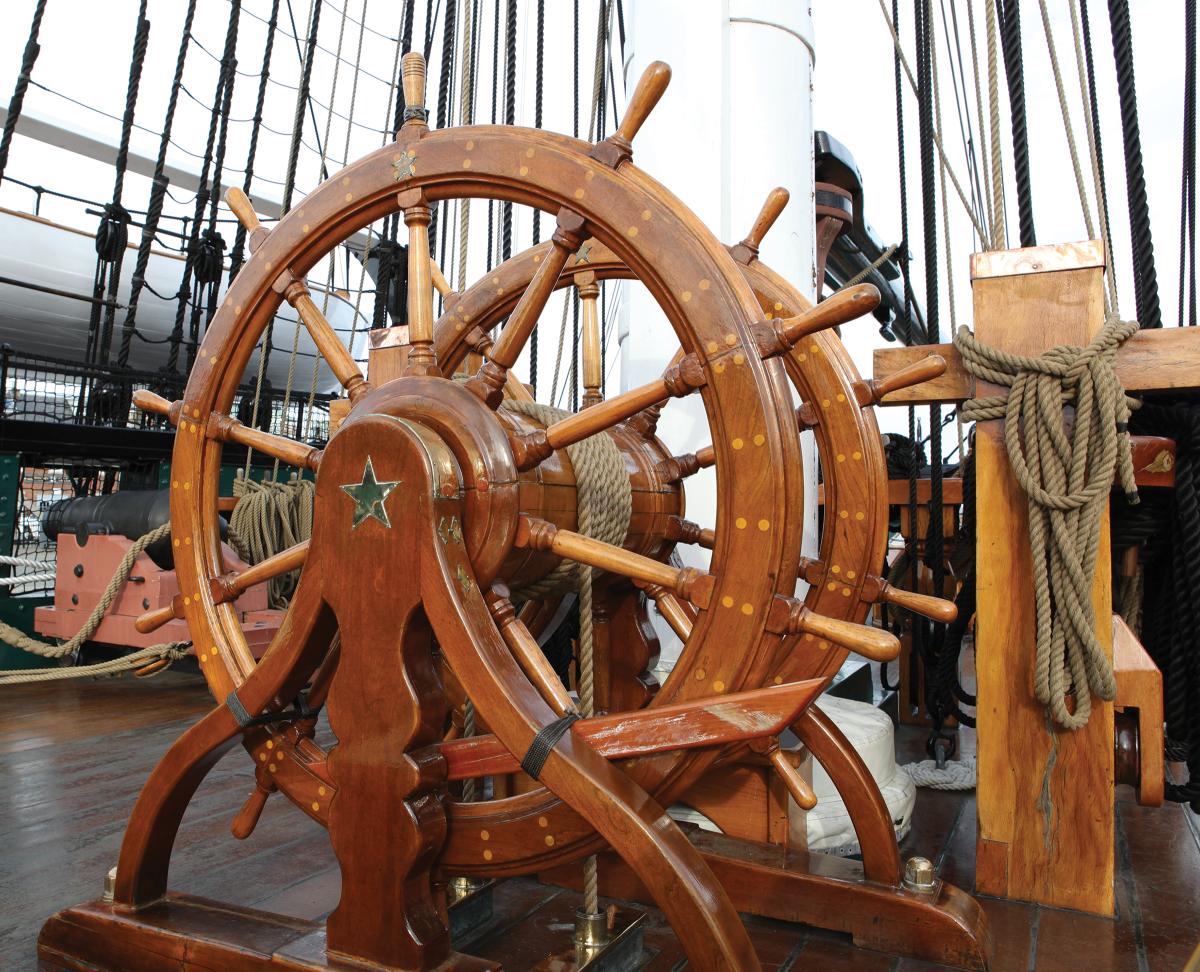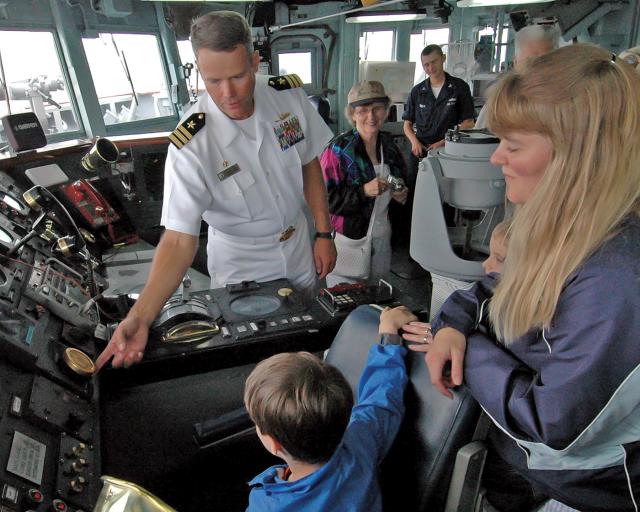Steering a ship with a wheel seems such a universal concept that it is hard to imagine a time when it was not done. But in fact, Columbus sailed the ocean blue without one, Magellan circumnavigated the world unaided by it, and the Mayflower safely landed the Pilgrims at Plymouth unassisted by one. The introduction of the ship’s wheel in the first decade of the 18th century was just the latest, and perhaps the most significant, step in the history of steering ships.
The February 2017 Naval History included an excellent recounting by retired U.S. Navy Commander Tyrone G. Martin of the early history of steering (“Steering a Ship with a Pole,” pp. 8–9). He outlined the evolution of mechanical aids, from the use of a special oar mounted on the counter of vessels in the ancient world, to the whipstaff—the “pole” of his title. As ships grew in size, their steering mechanisms had to evolve as well. When medieval sailing ships appeared, they were too large to be controlled by steering oars, which were replaced by a rudder hung from the stern post and controlled by a tiller.
By the 16th century, warships were becoming ever larger, with dedicated gun decks topped by raised poop and quarterdecks. The command-and-control center of these ships was on the highest deck, where the captain had reasonable visibility. Unfortunately, the tiller, still physically attached to the rudder head, now lay deep within the ship. The solution, Martin explained, was to use a vertical lever, the whipstaff, that passed through the intervening decks to the tiller. This allowed the helmsman to be positioned close to the captain. By the start of the 18th century, however, warships continued to increase in size, and the whipstaff’s limitations were becoming apparent.
For one thing, a whipstaff on a large ship could only provide at best 5 degrees of yaw either side of center. This was adequate for blue-water sailing, but not for maneuvering in battle or navigating safely through a busy roadstead. Steering bigger ships with larger rudders required the application of greater mechanical force, but the whipstaff was already as long as was practical. This only left mariners with the option of adding ever more helmsmen to do the physically demanding work of heaving on the lever, but this was not conducive to precise or subtle changes in course.
The solution was to find an alternate means of controlling the rudder, and this seems to have come about through an evolutionary process rather than a sudden change. In heavy weather, it was common practice on larger ships to disengage the whipstaff and steer by means of tackles (a system of ropes and pulleys, to the landsman) leading from the tiller end to the side of the ship, manned by lines of crewmen.
The next logical step was to extend these tackles up through the decks to a winch on the quarterdeck, and so replace the whipstaff altogether. This happened experimentally in the Royal Navy during the first decade of the 18th century. Once on the quarterdeck, the steering rope was wrapped multiple times around the drum of a winch before returning below. The helmsman now turned the drum, winding in one end of the rope, while at the same time releasing the strain on the other end. Far beneath his feet, this caused the tiller to swing and the ship to turn. Early models show the winch barrel was initially operated by handles, but these soon were replaced by a large wheel with spokes fitted to the end. The ship’s wheel had arrived.
So superior was the wheel to the whipstaff that it quickly was adopted by all navies, as well as large merchant ships. By the 1730s, its use was nearly universal throughout Europe, with only some maritime powers in the Baltic persisting with the older technology. Further small innovations included improvements to the geometric layout of the system to eliminate any slack and the addition of an indicator for the helmsman to show him the position of the rudder. This new steering method also had the benefit of being scalable with continued growth in the size of warships. Dual steering wheels were fitted to each end of the windlass drum in larger ships, and helmsmen could be positioned on both sides of the wheel if extra power was required.
As the 19th century unfolded, there was a quickening in technical innovation, particularly in ship design. Most important, steam gradually replaced sail as the principal motive power, which was to have a significant impact on steering wheels. Captains of sailing warships always had positioned themselves at the sterns of their vessels, largely because they needed to be close to the helmsman. It was not an ideal position in a fight, however, given that the view forward was obscured by masts, rigging, and sails. With the arrival of steam power, thick smoke now flooded back from the funnel to further obscure visibility.
But a solution was at hand. Early steam ships used paddle wheels mounted on the sides of the hull for propulsion. The sponsons that enclosed the wheels were connected by a raised platform running across the ship called a bridge. Forward of the funnel, with an excellent view over the deck as well as ahead, this now became the preferred position from which to direct the ship’s motion. The paddle wheel was soon replaced in warships by the mechanically more efficient screw propeller, but the transversal bridge was retained, and to this day the “bridge” remains the command-and-control center of a ship.
The only issue with this new arrangement was that the steering wheel still had to be located more or less directly above the rudder, which meant captains had to rely on speaking trumpets or voice pipes to relay course changes to the helm. This was less than ideal for any vessel and could break down entirely during the noise of combat on board a warship. Fortunately, the ever-increasing size of ships would provide a solution to this problem, too.
At the same time that steam power was being adopted, iron was replacing wood in hull construction. The result was that ships of previously unimaginable size became possible. Isambard Kingdom Brunel’s Great Eastern, laid down in 1854, had a displacement of 32,160 tons—more than three times as much as the next largest ship afloat at the time.
The limitations of nonmechanized steering already were becoming apparent even before this huge ship was launched. HMS Minotaur, a Royal Navy ironclad and near-contemporary of the Great Eastern, was a considerably smaller ship. Yet in poor weather she required 78 men heaving on blocks and tackles to help her helmsmen steer. Clearly, no ship’s crew could possibly control the huge rudder of a leviathan like the Great Eastern unaided.
With typical inventiveness, Brunel solved the problem by introducing the first steering engine. The device, designed by Scottish engineer John McFarlane Gray, was a steam-powered mechanical amplifier used to drive the rudder. A steam cylinder ran across the axis of the ship’s rudder arm, actuating a mechanical valve and forcing the rudder either to port or starboard. The power of the cylinder meant that a single sailor at the wheel could once again control a ship. The change also meant that, for the first time, the helmsman was not physically moving the rudder by linkage, and so no longer needed to be positioned above it. The ship’s wheel was relocated to the bridge, and captain and helmsman were reunited. They have remained together ever since.
Perhaps the most interesting aspect of the steering wheel is the way it has endured. So familiar has it become that we take it for granted, but for much of maritime history steering was controlled by other means. The steering oar directed ships for 4,000 years, from the ancient Egyptians to the invasion fleet of William the Conqueror in 1066. Even the tiller that replaced it is still in use in most small boats today. The only reason a circular wheel with spokes was adopted was for the mechanical winding of a rope around a windlass.
With that function gone, there is no logical reason ships could not be steered by a simple lever today. Yet, far from disappearing, the steering wheel has multiplied, appearing in automobiles and civilian aircraft, for example. Some modern ships have attempted to dispense with steering wheels altogether, but with limited success. The U.S. Navy replaced the wheel with a 3-inch knob for the Oliver Hazard Perry–class guided-missile frigates. Despite its functionality, there is nevertheless something lacking in this form of control, and more recent Navy ships, such as Arleigh Burke–class destroyers, have returned to a more traditional wheel.




